According to a widely reported stat, returning customers spend 67% more than new customers. To keep your customers coming back and boosting your sales, consider implementing a customer loyalty program that will reward shoppers and encourage their retention.
This article explores 13 customer loyalty program ideas you should consider when starting your retail business or looking for ways to improve sales performance.
1. Give First-time Purchase Discounts to Attract New Members
First-time offers are a significant part of acquiring new customers—a frequently cited source reports that four out of five shoppers feel encouraged to make a first-time purchase after getting a discount or offer.
For ecommerce stores, shoppers can’t touch or experience online products, and it’s hard for them to know what to expect from an unknown retailer. This generates more buying hesitation and a greater need to create incentives for people to take the plunge and try your shop.
Incentivize a sale by giving new shoppers a first-time purchase offer that will help them get over the hesitation that comes with trying a new retailer.
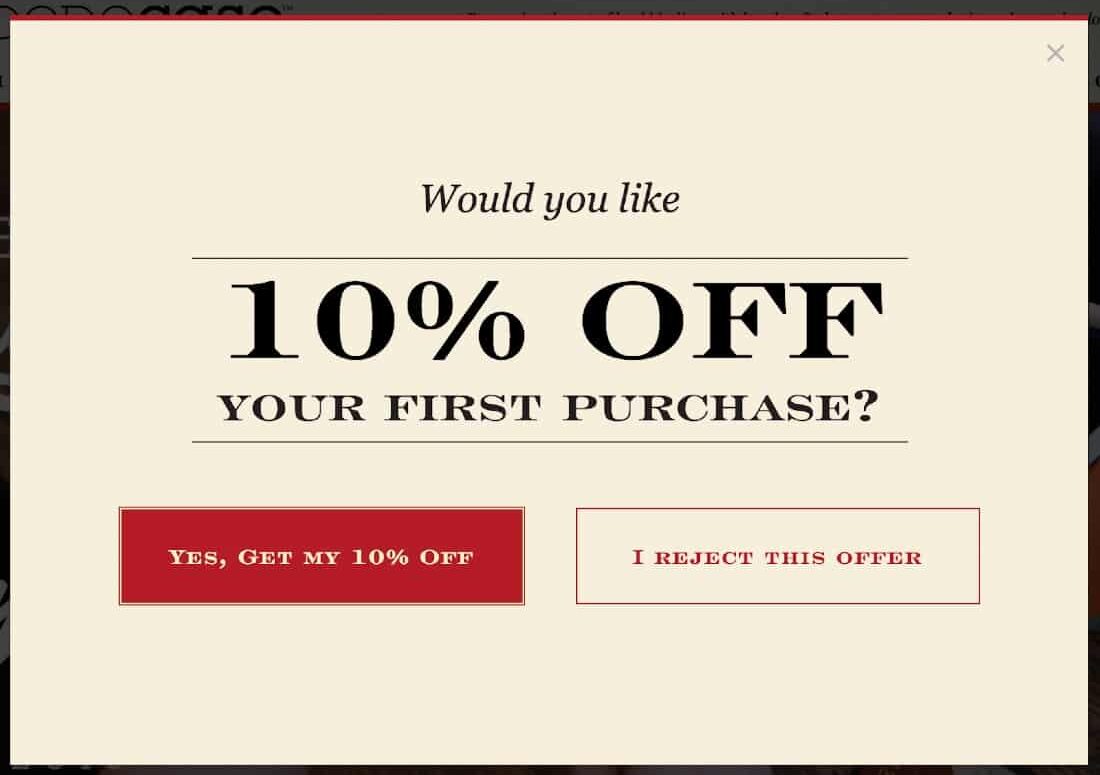
Online retailers will often advertise their customer loyalty program with popup ads. (Source: Shopify)
Example: Pampelone
Pampelone is an online women’s clothing boutique that sells high-end women’s dresses and knits. With its pieces running a high ticket and there being no way for people to experience them firsthand, Pampelone works to overcome first-time purchase hesitation with a $10 discount for new shoppers.
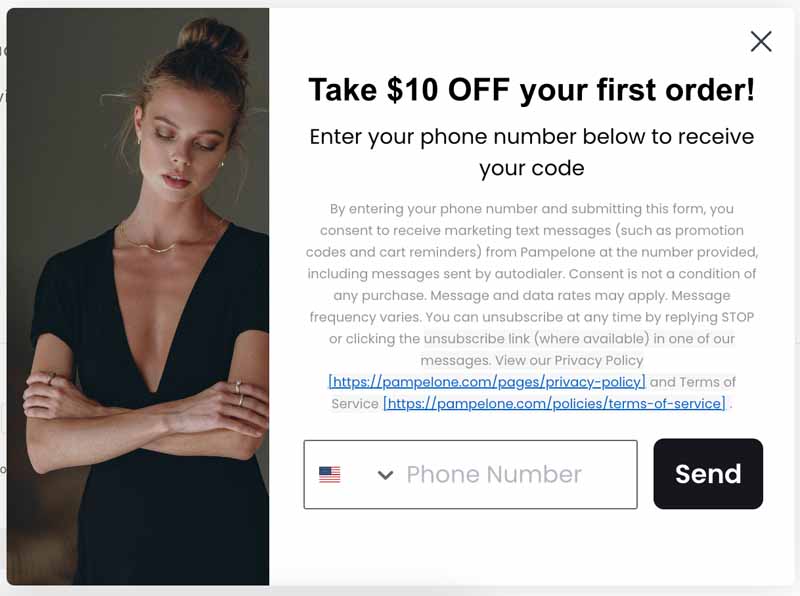
Pampelone offers a $10 discount for first orders, helping shoppers overcome purchase hesitation.
2. Reward Customer Referrals
A referral program is a word-of-mouth (WOM) marketing strategy where you offer rewards to current shoppers when they tell their friends about your store. This strategy not only helps boost your overall traffic but also comes with built-in buyer trust.
One way to introduce a referral program is through custom links tied to customer accounts. Customers can copy their custom link and share it with friends. Then, you can track and reward that customer based on the resulting actions. You can acquire custom links either from a referral service or through customer loyalty software.
Alternatively, you can give customers a discount code to share with friends. They then get access to a discount once their friends redeem their codes. For example, you can give customers a sharable 20% off code, and when their code gets used, they, too, get a 20% off code.
You can (and should) use social media as part of your referral program. Consider hosting contests where people have to tag their friends for entry or creating custom links to your social pages that customers can share with their connections.
Loyalty programs such as LoyaltyLion allow you to create custom referral links for sharing on social media, via email, or over text. You can read more about LoyaltyLion and our other picks in our guide to the top loyalty program software.
Example: Girlfriend Collective
Free items are another way to encourage referrals. Sustainable athleisure brand Girlfriend Collective rewards referrers with a free pair of leggings rather than a discount code. Referred customers also get a first-time purchase discount.
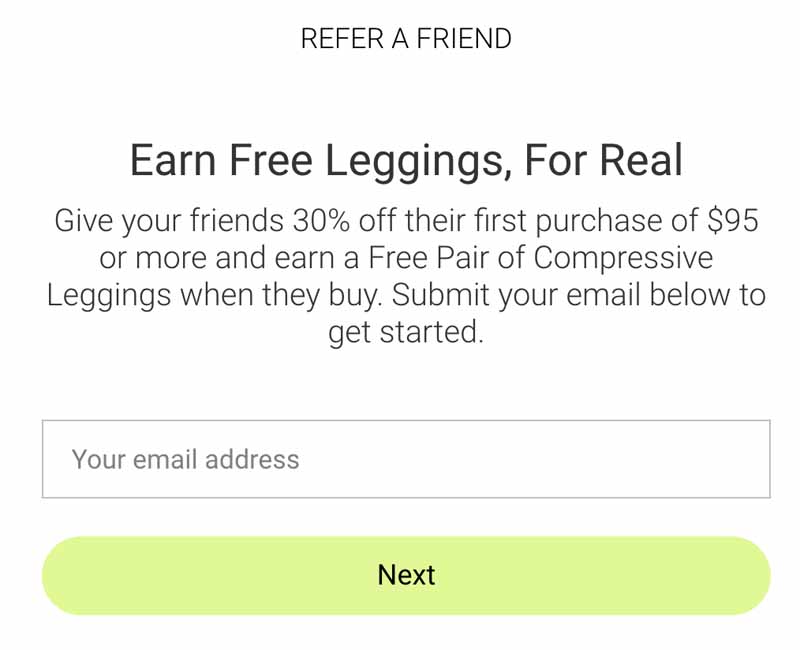
Girlfriend Collective’s referral program lets customers earn free leggings instead of a discount.
3. Award Points for Spending
Next on our list of customer loyalty program ideas to boost engagement is a points program. In a points system, customers are rewarded with points when they do certain things, whether that be spending, writing reviews, visiting your shop—anything you choose. Those points can then be redeemed for rewards that are, again, completely up to you (e.g., discounts, gift cards, special offers. etc.).
Here are several ways you can structure your loyalty points program:
- Spend-based Program: A spend-based program offers points based on dollars spent. This type of points program is best suited for companies that want to incentivize larger purchases.
- Visit-based Program: This points program gives points based on the number of customer transactions and is best for businesses that rely on frequent, small purchases.
- Loyalty Actions Program: A loyalty actions program is when award points are based on your defined loyalty actions. These actions might be commenting on a social media post, reviewing your products, shopping on a sale day, or buying more than two items. You define the actions that you want to see from your customers and that most benefit your brand. You can also create incentives with rewards and watch as customers start acting.
It’s worth noting that today’s loyalty programs still lean heavily on cash rewards, with 59% of most B2C businesses offering cash back.
Example: Nordstrom
Nordstrom has a very popular loyalty program dubbed “The Nordy Club” that operates on a points system. In The Nordy Club, customers earn points based on how many dollars they spend and get both cashback and exclusive access as they accrue more points. It’s a great example of a points program that not only leverages money-back rewards but also exclusivity to grow its program.
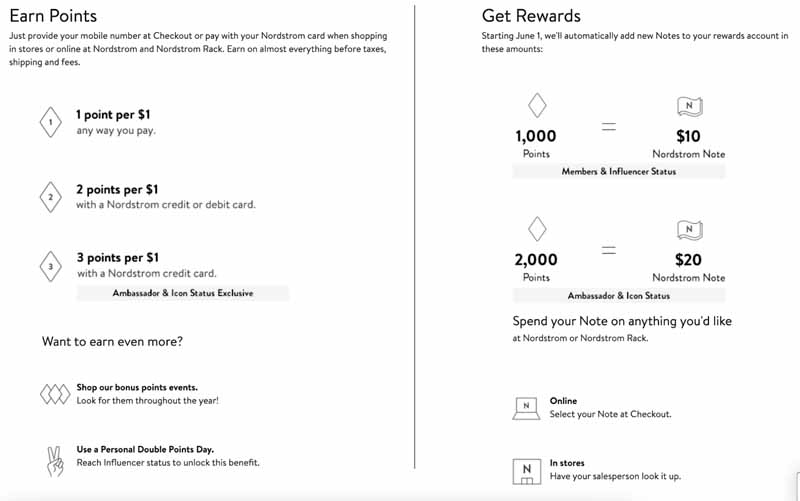
Nordstrom’s Nordy Club shoppers earn points with each purchase and can reach different levels to earn more rewards.
4. Create Perks Based on Tiers or Levels
Exclusivity is increasingly important to the modern shopper. Capitalize on this desire with a tiered membership structure.
In this model, as customers engage and spend more at your business, their loyalty status increases, giving them access to exclusive deals and offers (similar to The Nordy Club example above). Shoppers are incentivized to continue to frequent and spend at your business so that their status and offers improve and become more exclusive.
Tip:
Clearly advertise the offerings that come with a higher membership so that people know what they’re missing out on at their lower tier and are incentivized to reach the next level.
Typically, tiered programs have at least three levels and are tied to a points system. In other words, the number of points you have determines what membership tier you get to be in. This helps streamline the membership process and makes things easier to track and implement.
Example: Sephora
Sephora, a major makeup retailer, has a popular tiered loyalty program known as the Beauty Insider Program. Here, members can either be an Insider, a Very Important Beauty (VIB), or a Rouge, based on their points.

As members climb the ranks of Sephora’s Beauty Insider Program, they get better deals, greater discounts, exclusive freebies and events, and earlier access to Sephora’s rare sales.
5. Gamify to Boost Engagement
As consumers are increasingly distracted and difficult to engage, gamification is becoming an important part of retailers’ marketing strategies. Gamification is the process of introducing game elements—like competitions and scoreboards—into areas where they’re not typically found, like your loyalty program. The goal of gamification is to boost engagement and drive sales.
Retail holds the largest share of the global gamification market. And when Walgreens employed “gamification” tactics, it reported an 30% increase in engagement and loyalty.
You can gamify your loyalty program in a few ways with the help of gamifying tools:
- Virtual reality (VR): Get customers to interact with your brand in an exciting and engaging way by using technology like VR.
- Contests: Contests with prizes boost your engagement. Maybe you do a raffle where every referral counts as an entry, or you offer a special discount to your top monthly point holders. Get creative and motivate people with prizes that they actually care about.
- Prize wheels: Let customers spin a wheel with different prizes and discount offerings. You can either create a prize wheel pop-up for your website or install a physical one in your store. Either way, you are sure to get people involved.
- Scratch-off: Create a scratch-off game that customers can get involved in as they buy more products. For example, say you add a scratch-off sticker to your large coffees, and if a customer gets a three of a kind, then they get a free large drink and pastry of their choosing.
Example: Throtl
Throtl is a car parts and gear ecommerce website that uses car giveaway contests to get people excited about spending and to boost engagement. If you’re a Throtl VIP member, you pay around $10 a month to get access to your special rewards and offers, along with entries into a car raffle. For everyone else, every dollar spent equals one entry into the contest. This way, customers are incentivized to spend because of the prospect of a car prize.

With Throtl’s “Sweepstakes,” customers get one entry for every dollar spent to win a prize.
6. Run Special Events With Rewards & Limited-time Offers
Offer exclusive member discounts for special events, holidays, product launches, and anniversaries. You could even offer double rewards for a specific spending period or run a promo to see who can rack up the most points during a campaign. These types of limited-time and event-centered promos are highly effective at motivating shoppers and creating buying incentives.
Most customer loyalty program software allow you to send messages and emails to promote events and offers.
Example: Sweetwater
Music supply store Sweetwater has a loyalty program with its own currency: Bonus Bucks. Loyalty program members can collect points with any purchase at any time—but they’re eligible for more rewards during a Bonus Bucks promo. These limited-time promos are a great way to get people to spend at key times and create extra incentive to shop.
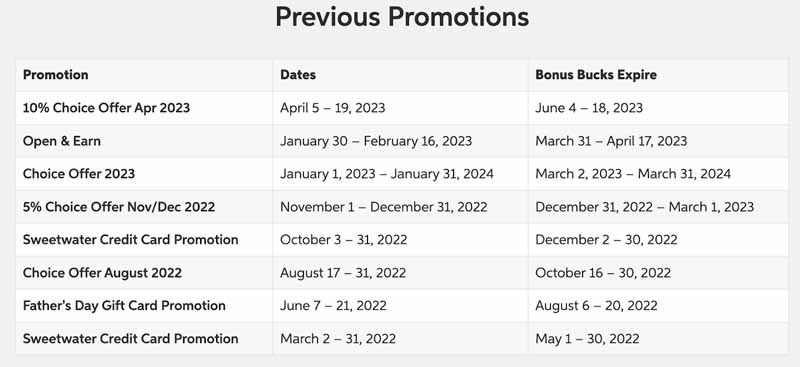
Sweetwater’s Bonus Bucks can be redeemed during specific promotion periods.
7. Offer Paid Loyalty Programs
While most loyalty programs are free, some come with a membership fee. Usually, paid or premium loyalty programs require members to pay an upfront fee (monthly or annually) in return for exclusive benefits such as bypassing common purchase barriers later on (like shipping fees).
Once members join the program, they’re more inclined to spend to maximize the program benefit. This, in turn, should lead to increased average order values, higher repeat purchase rates, and more customer lifetime value.
95% of retailers considered launching a premium loyalty program in 2021.
However, a member will only be a repeat customer as long as they’re enrolled. And if they don’t think the benefits are worth paying for, they’re likely to cancel their membership. To keep people in a paid program, you need to offer value that goes above and beyond the fee and makes customers believe their membership is truly worth it.
Examples: Amazon, REI, Birchbox
- Amazon Prime’s membership fee unlocks free shipping. This feature allows subscribers to make frequent, repeat purchases without worrying about inconveniences.
- REI’s lifetime co-op membership requires a one-time $30 fee. Members then accrue points with purchases, can trade in used gear, get free shipping, and get access to exclusive products and discounts.
- Birchbox is a monthly beauty subscription program that offers many benefits to its subscribers, plus an added incentive for those who stick around. The ACES program is only activated once you’ve spent $300—a smart strategy to encourage customer retention.
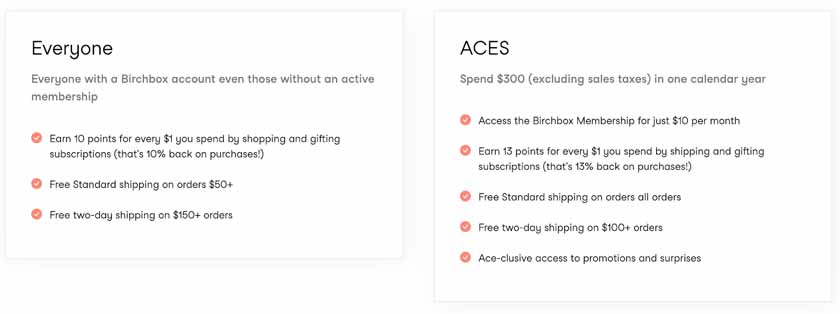
Customer retention is a challenge even for those that offer paid loyalty programs. Birchbox solved the problem by offering added incentives for long-term paying subscribers.
8. Roll Out Mission-driven Loyalty Programs
Consumers are increasingly looking for ways to align their spending with their personal values. In fact, two-thirds of customers are more willing to invest in brands that take stances on social and political issues they care about.
To tap into this, you need to know your buyers’ ideals and values so you can create a campaign that supports them. From there, advertise your campaign and build customer trust and loyalty with your altruistic undertaking.
Examples: Toms and Body Shop
- TOMS shoes has a free, point-based reward system that allows customers to donate their points to support their listed foundations—a variety of awesome grassroots partners. These points correspond to a monetary value.
- Body Shop’s Love Your Body Club also offers a point-based system where you have the option to redeem them for discounts or donate to a variety of charities. Members also receive a $10 coupon for their birthday.
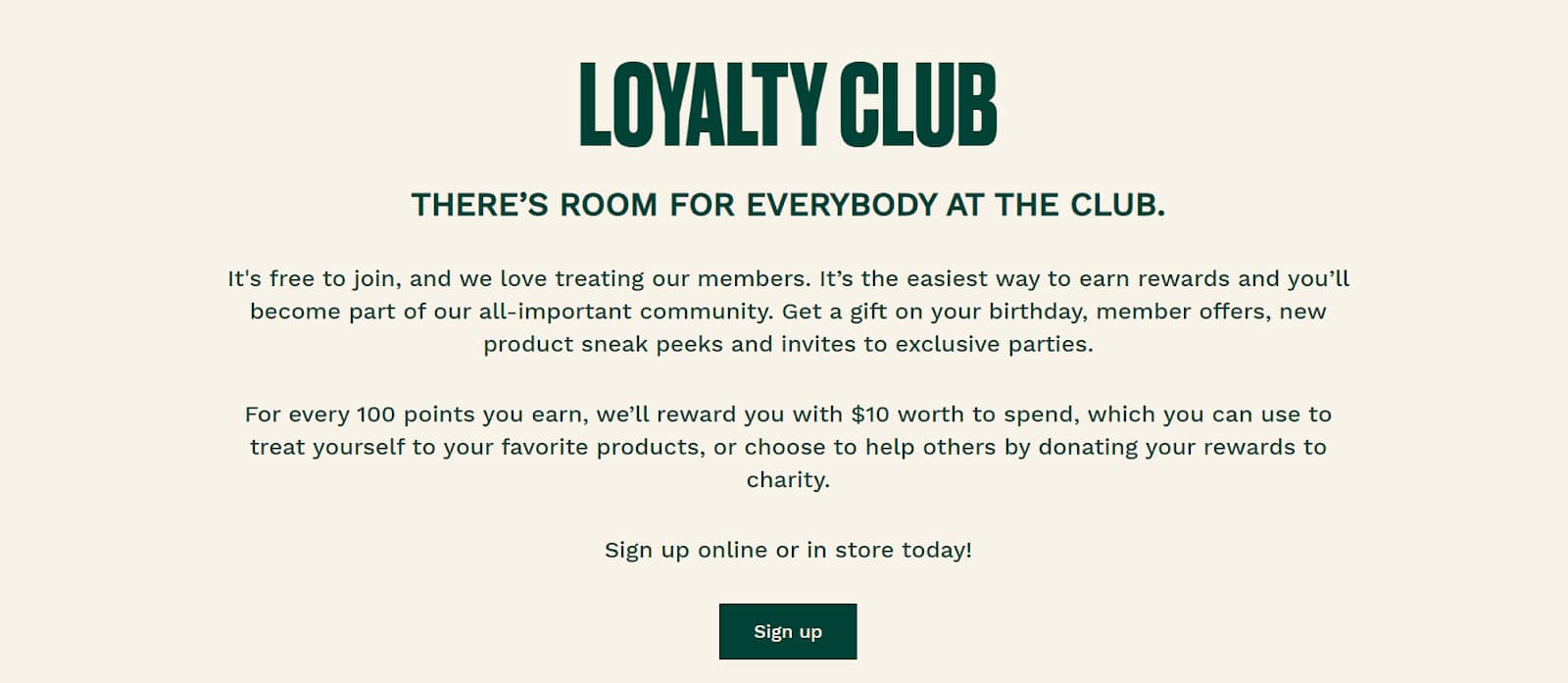
The Body Shop brings a lot of social responsibility sentiment to its rewards program.
9. Dispense Rewards Annually
Ideally, your loyalty program members are making multiple purchases throughout the course of a year. While some brands release points as you accumulate them, others decide to award points one time each year.
This annual touchpoint gives you a reason to touch base with your audience. So if they haven’t shopped with you in a while, this is the perfect reminder to change that. Plus, it gives you a chance to reflect back on your year together as a customer-brand relationship.
Example: Seea
Sustainable swimwear brand Seea rewards its customers annually via email. It doesn’t advertise or promote this initiative—rather, the brand opts for a surprise and delight approach. Customers find an email in January with their rewards in the form of a gift card.
10. Use Punch Cards
Physical punch cards are the old-school approach to loyalty programs. The premise is simple: get X punches, and you earn a reward. They serve as physical (or digital) reminders to visit your business and create incentive to keep coming back so you can get a reward.
Today, many punch cards are digital, and you can access them through apps and QR codes.
Example: Kaldi’s Coffee
Kaldi’s is a coffee shop franchise based in St. Louis. Located in neighborhoods around college campuses and in walking neighborhoods, Kaldi’s knew its target market was “the neighborhood regular.” This shopper makes frequent, small purchases and is either on the go or taking over a cafe table to camp out for the afternoon.
In an effort to speak to this customer, Kaldi’s created a punch card-style loyalty program that rewarded regular customers with a free coffee after 10 purchases. Additionally, when they filled out three punch cards, they got a Kaldi’s mug that they could bring with them for their daily cup. Not only this, but employees would make efforts to know loyalty cup holders’ names and their regular orders.
This program was highly successful, fostering regular visits and brand loyalty hedged in a sense of community.
11. Go Paperless
More than ever, the modern shopper wants a completely digital experience. Provide them a paperless option to redeem loyalty rewards or points through the following:
- If you’re using loyalty program software, creating a digital loyalty program is easy, as most software will track customer points and rewards and allow you to access purchase histories and more. Additionally, most software options have an integrated customer portal via an app or website for customers to access their loyalty member accounts and check their status online.
- Send text or email announcements rather than handing out flyers, use a digital points tracking system rather than physical punch cards, and give out digital coupons instead of printed ones. Whatever you can do to make your customers’ lives easier will help you attract people to your loyalty program and grow your base.
Did you know?
Digital coupons have overtaken traditional paper coupons, with digital coupon redemption the preferred method across age groups, even Baby Boomers (50%).
Example: Safeway
A great example of this is Safeway’s digital loyalty program. Unlike traditional grocers, Safeway does not use any physical cards; rather, an employee signs you up on their computer. Then, each time you check out, you provide your phone number. This pulls your account up and gives you access to your rewards.
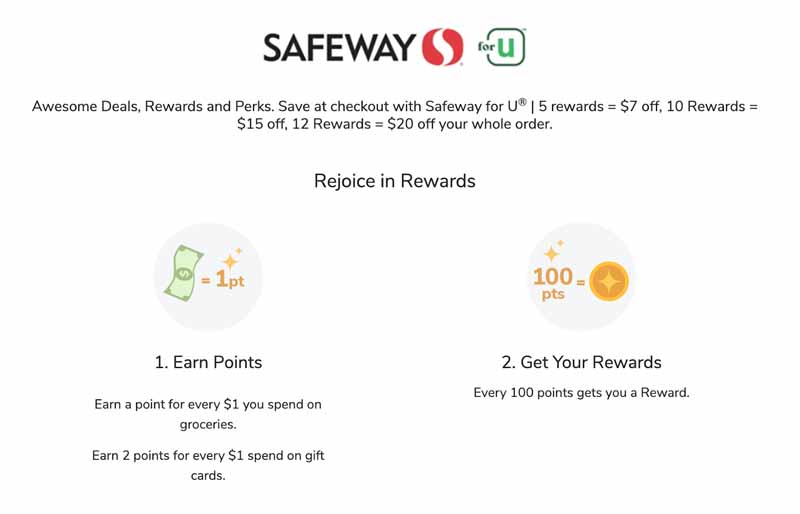
Joining Safeway’s loyalty program is easy, and continuing to get access to deals and rewards requires no effort.
12. Give Members Something for Free
Everyone loves a freebie. If you can include free gifts as part of your customer loyalty program, you’ll have a lot of happy members and a higher sign-up rate.
Freebies can include a diverse range of incentives. You might simply offer free shipping to all loyalty program members. Or, you might go above and beyond and gift a free product once members hit a spend or referral threshold.
Whatever the freebie is, make sure it’s relevant and enticing. You might tailor the freebies based on the qualifying purchase or even give shoppers the chance to choose which free gift they’d like to receive.
Example: bareMinerals
bareMinerals is a makeup brand that offers a free sample with every order and sends discounts and offers for most holidays via its loyalty texting and email program. The beauty brand capitalizes on every opportunity to do event-based limited-time offers and has become a successful company doing so.
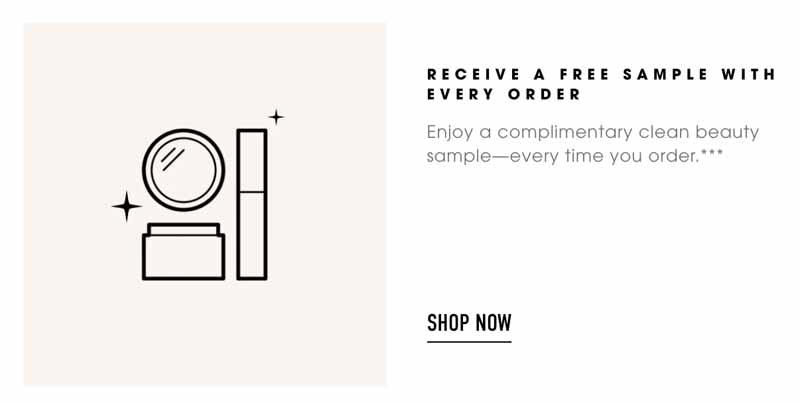
bareMinerals entices customers with a freebie at every purchase.
13. Celebrate Customer Birthdays
Another customer loyalty program idea you might try is to incorporate birthday promos. Simply collect birthday information when shoppers sign up for your loyalty program, and then send them an email or SMS message with a birthday offer when their big day comes around. An offer plus a day about celebrating themselves is a great recipe to get the birthday shoppers buying.
You can either track and message customers for their birthdays by hand or use a provider like Fivestars (another one of our best loyalty program software) for an automated solution.
Example: Stella & Dot
Stella & Dot Jewelry has three different loyalty program tiers, though all three qualify members for a free birthday gift. It’s free to join, and customers can advance to the Insider and VIP tiers if they spend at least $200 and $600, respectively.

All loyalty program members qualify for a free birthday gift at Stella & Dot Jewelry.
Tips for Implementing a Customer Loyalty Program
Whichever loyalty program ideas you decide to implement, keep the following tips in mind.
Before you set out to create your customer loyalty program, it’s important to understand your target market and the strategies that will resonate with them. For example, the demographic that shops at a baby boutique would probably love to get a free bottle with a $75 purchase, but this same rewards structure wouldn’t be effective for the market that shops at sports and outdoors stores.
- Ask yourself whether customers will like your idea. Will it make them want to come back? Is there anything you can do to make the idea more on-brand?
- Use reporting tools within your customer loyalty software so you can analyze buyers’ behavior.
- Use A/B testing on your customers—this greatly helps test new ideas and weed through strategies that do and don’t work.
- Monitor how your loyalty program is performing over time so you can make adjustments and create the most effective program for your business.
Building on the concept above, you should also ensure your loyalty program is consistent with your brand to create a cohesive experience for your customers. Good branding in your loyalty program will help reinforce your business in customers’ minds and make it more recognizable in the future.
- Be consistent with your branding when it comes to developing materials for your loyalty program—from colors and logos to themes.
- More than visual branding, ensure that the verbiage you use is in your brand voice, the images reflect your brand image, and any strategies you choose make sense with your overall branding scheme.
WeWoreWhat is a growing clothing brand with a huge emphasis on branding in its customer loyalty program. Its brand appeals to a fashion-forward city girl, who’s always on the go and forever stylish. Some may call her “the girl boss.”
WeWoreWhat refers to all its members as “babe,” uses sassy messaging, and offers a loyalty structure that rewards large, infrequent purchases. The tone of the program is in line with its city girl aesthetic, and the rewards structure helps foster big sales for its infrequent drops.

Creating a cohesive brand experience will help you drive sales and breed loyalty. (Source: Affiliate Eye)
One white paper from Comarch says shoppers have an average of 14.8 loyalty program memberships but are only active in half of them. While acquiring loyalty members might be easy no matter what program you roll out, keeping them engaged is another story.
Offering rewards instantly and more frequently helps keep your loyalty members active and engaged. For example, you can give incentives or rewards just by letting them add or update their profile data preferences. In turn, you can use this updated information to develop more events and promotions. These small perks keep members connected with your brand.
No matter the loyalty program, the key to keeping people consistently more involved in it is to regularly reach out to them via text or email. Let your loyal members know about your upcoming sales or discounts, remind them of their points and rewards, tell them about new products or exciting changes, or offer them an exclusive deal. Remember, brand loyalty is ultimately a relationship between you and your customers, so don’t treat them like strangers.
Some loyalty software like Smile.io and Fivestars have automated loyalty messaging where you get to choose certain triggers, and then messages get sent out automatically. For example, you could have a trigger that sends texts to people who haven’t been by your coffee shop in a week or an email trigger that correlates with your sales schedule.
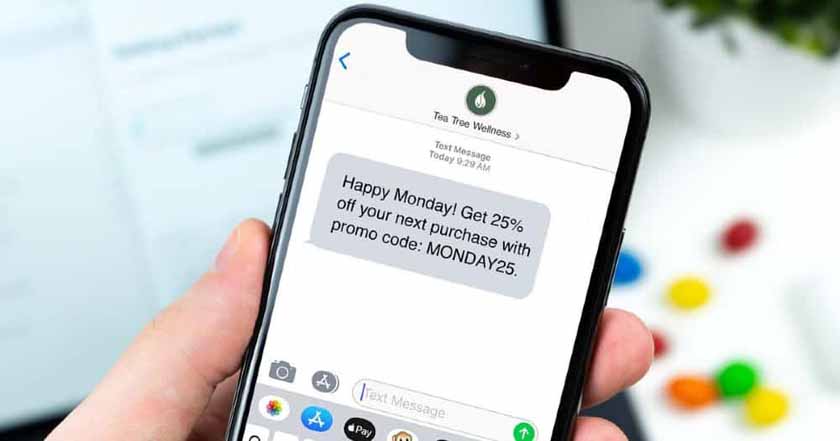
Use text marketing to engage with your customers. (Source: Mindbody)
Ready to get started? Learn how to create your customer loyalty program and choose from our recommended top loyalty software programs.
Bottom Line
Today’s customer loyalty programs should center around customer engagement both inside and outside of the buying cycle. We recommend incorporating a mix of the above-mentioned customer loyalty program ideas and changing your strategy from time to time in order to foster lasting brand loyalty and retain customers year-over-year.
